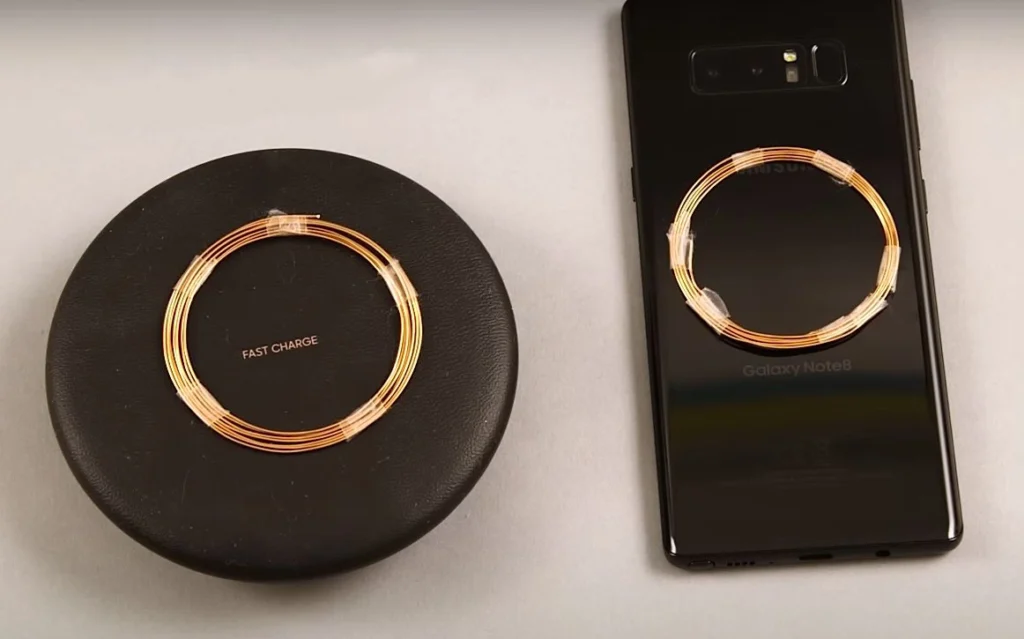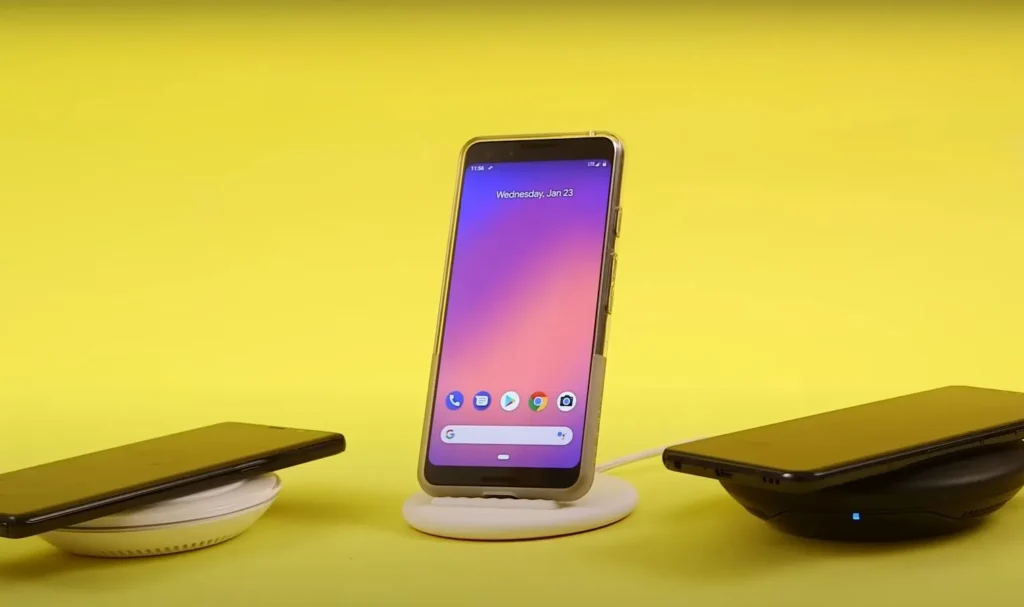Qi, which translates to “power flow” in Chinese and is pronounced “chi” in English, is a standard used worldwide for wireless charging of battery-operated devices like cameras, cell phones, and players. The process of electromagnetic induction is used to transfer power. In this instance, power is received by the receiver via electromagnetic fields rather than a conventional cable in a non-contact manner. The idea is very straightforward: the base station, or Qi transmitter, directs the required energy to the receiver.

Description of technology
Magnetic induction between the flat coils of the transmitting and receiving devices is the foundation of the Qi wireless charging standard. A coreless resonant transformer consists of two parts: the primary and secondary coils. Both the top and bottom surfaces of the secondary and primary coils are shielded from the charger circuit. This ensures a respectable power transfer efficiency along with the close proximity. Furthermore, it reduces the users’ exposure to the magnetic field. The base station usually has a level area where one or more mobile devices can be positioned. This guarantees a sufficiently small vertical separation between the primary and secondary windings. Furthermore, there are two methods for horizontal winding alignment. In the first scenario, the user uses the mobile device’s prompts to independently place the secondary winding on the interface surface opposite the primary winding.
The second technique is known as free positioning, and it doesn’t involve direct human involvement. For this purpose, multiple primary windings are created in one implementation. In a different variation, the primary coil is moved beneath the secondary coil mechanically.
Parts of the Design
The power conversion unit and the communication and control unit are the two primary functional units that make up the power transmitter. The primary coil is the component of the former that produces the magnetic field. The second one adjusts the power that is transmitted to a level that the recipient requests. Furthermore, because a single primary coil can only communicate with one secondary coil at a time, the base station may have multiple transmitters to service numerous mobile devices. Lastly, the system unit powers various transmitters and regulates their operations. The device houses the communication and control unit in addition to the power receiving unit, which is the secondary winding. The latter controls the transmitted power to a level that is suitable for the subsystem that is linked to the receiver’s power output. An instance of a rechargeable battery subsystem is one of these.
Communication phases
Upon activation, the transmitter transmits a signal to the receiver in order to receive a response verifying the existence of a Qi-compatible device. The receiver goes into the selection phase after receiving the request. Pinging starts if the voltage being offered is high enough. The mobile device either sends a signal strength packet and moves into the identification and configuration phase after getting a response from the transmitter, or it sends a power termination packet and stays in the pinging phase. Next, packets for identification and control are sent. The receiver starts the process of charging. In addition, it regulates the energy transfer by transmitting control packets to the base station that include data regarding the adjustment of the primary winding current, the energy received, the state of charging, and the completion of the transfer.
A wireless charging point: What is it?
Because it allows for compatibility between various manufacturers’ power adapters and cell phones, Qi charging is considered universal. The transmitter and receiver must both be Qi compliant, and that is the only requirement. Therefore, regardless of brand or model, any Qi wireless charger is compatible with any Qi mobile receiver. Numerous smartphones from various manufacturers, such as Samsung, Nokia, LG, Sony, HTC, and Motorola, already comply with Qi standards and can thus be linked to any charging station that satisfies its prerequisites. The growing number of companies supporting wireless power transfer technology means that there are an increasing number of compatible gadgets available. This allows electronics that run on batteries to be charged using a single power source.
How does it function?
The invention of the mobile charger is not new. Inductive power has been a feature of electric toothbrushes for a long time. Resonant inductive coupling is used in the wireless power transfer process between the cell phone receiver and base station transmitter. In order to detect any changes in capacitance or resonance that might point to the presence of a compatible phone, the primary coil continuously transmits a test signal to the sender. In addition to modulating the charge, the transmitter verifies that the Qi wireless charging standard is enabled.
The inductive power transfer process starts after compatibility and power requirements are considered. The transmitter and receiver stay in contact with each other. They enter standby mode after the battery is fully charged. Only when the device to be connected is powered on does the universal charger turn on and begin to transfer energy. In order to minimize electromagnetic radiation, the coils that transmit and receive energy are specially shielded.
Key characteristics of the technology
A non-contact power transfer technique that uses the near-field magnetic induction that happens between the coils to transfer power from the base station to the mobile device. 5 W of power can be transmitted with the use of a suitable secondary coil, which typically has an external diameter of 40 mm. operation between 100 and 205 kHz in frequency. Support for two placement strategies on the base station’s surface: random placement on the charging station’s surface or guided positioning, which helps the user place the mobile device correctly at a spot that receives power from one or more fixed points. A straightforward protocol for communication that lets the tablet or phone take the lead. Enough design leeway to incorporate the system into a portable device. Minimal standby power usage (subject to implementation).
Everybody for one
Without a lot of tangled cables, how handy would it be to have a single Qi charger for all phones, players, and cameras? The world is flooded with new smartphones, but their battery life is getting shorter and shorter. Additionally, each manufacturer and device has a unique charger. And their number rises with each purchase. Eventually, the user finds themselves lost in a maze of different power adapters.

Qi-technology eliminates the need for them and eliminates cable tangles, but these are not the only benefits of this technology. Just as Bluetooth eliminated the need to hold a phone in your hand and Wi-Fi established wireless Internet connections as the norm, Qi is doing the same for inductive charging of devices that run on batteries.
Is there a risk of electromagnetic radiation?
Expert opinions differ from one another. On the one hand, a large number of scientists attest to the safety of a tiny quantity of electromagnetic radiation from wireless charging. Others discuss the enormous risk that the human body faces. What is the amount of electromagnetic energy that the Qi system emits then? Not at all. Electric toothbrushes have been using the Qi principle for many years without any negative effects on human health. The charger’s circuitry is designed to produce very little electromagnetic radiation because of its small operating area. It only exists when the device is on the wireless transmitting station and in close proximity to it. More shielding in the transmitting and receiving coils lowers the electromagnetic radiation even more.
Wireless Power Consortium
On December 17, 2008, the Wireless Power Consortium (WPC) was established. A unified program for this technology’s development was approved at the same time. The Qi wireless charging standard guarantees that all electronic devices that are compatible with Qi technology can use it. This implies that any Qi-compatible station can be used to charge any device that is compatible with it. With 250 members, including the top players in the market—Samsung, Nokia, LG, Panasonic, HTC, Sony, Microsoft, and Motorola—WPS is the largest manufacturer association supporting wireless chargers. WPC chairman Menno Treffers says it’s critical to ensure that every mobile charger is compatible with all Qi-enabled devices due to the growing number of products that use the technology. This is made possible by Testronic’s dynamic database, which simplifies the process of figuring out whether a new product will work with ones that have already received certification. With phones and tablets being used on a daily basis at home and at work, the Qi wireless charging standard has emerged as one of the most significant technological advancements for consumers.